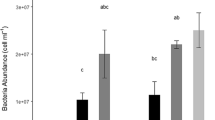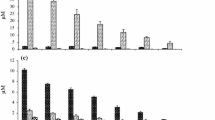Abstract
We examined the impact of exposing natural populations of marine bacteria (from seawater collected near Woods Hole, Massachusetts, USA) to multiple nitrogen and carbon sources in a series of batch growth experiments conducted from 1989 through 1990. The substrate C:N ratio (C:Ns) was varied from 1.5:1 to 10:1 either with equal amounts of NH +4 and different amino acids or an amino acid mixture, all supplemented with glucose to maintain the C:Ns ratio equal to that of the respective amino acid, or with combinations of glucose and NH +4 alone. A common feature of the experiments involving amino acids was the concurrent uptake of NH +4 and amino acids that persisted as long as a readily assimilable carbon source (glucose in our case) was taken up. There was no net regeneration of NH +4 , even though catabolism of amino acids occurred. Regeneration of NH +4 was evident only after glucose was completely utilized, which usually occurred at the end of exponential growth. The contribution of15NH +4 to total nitrogen uptake by the end of exponential growth varied from ~60 to 80% when individual amino acids were present and down to ~24% when the amino acid mixture was added. These estimates are conservative because we did not account for possible isotope dilution effects resulting from amino acid catabolism. When NH +4 and glucose were the sole nitrogen and carbon sources, there was a stoichiometric balance between glucose and NH +4 uptake over a wide range of C:Ns ratios, leading to a constant bacterial biomass C:N ratio (C:NB) of ~4.5:1. As a result NH +4 usage varied from 50% when the C:Ns ratio was 3.6:1, to 100% when the C:Ns ratio was 10:1. Gross growth efficiency varied from ~60% when NH +4 plus glucose were added alone or with the amino acid mixture, to 47% when the individual amino acids were used in place of the mixture. It is thus evident that actively growing bacteria will act as sinks for nitrogen when a carbon source that can be assimilated easily is available to balance NH +4 uptake, even when amino acids are available and are being co-metabolized.
Similar content being viewed by others
Literature cited
Ammerman, J. W., Fuhrman, J. A., Hagstrom, A., Azam, F. (1984). Bacterioplankton growth in seawater. I. Growth kinetics and cellular characteristics in seawater cultures. Mar. Ecol. Prog. Ser. 18: 18–39
Bada, J. L., Lee, C. (1977). Decomposition and alteration of organic compounds dissolved in seawater. Mar. Chem. 5: 523–534
Barak, P., Molina, J. E. A., Hadas, A., Clapp, C. E. (1990). Mineralization of amino acids and evidence of direct assimilation of organic nitrogen. J. Soil Sci. Soc. Am. 54: 769–774
Billen, G. (1984). Heterotrophic utilization and regeneration of nitrogen. In: Hobbie, J. E., Williams, P. J. LeB. (eds.) Heterotrophic activity in the sea. Plenum Press, New York, p. 313–355
Bratbak, G. (1985). Bacterial biovolume and biomass estimations. Appl. envirl Microbiol. 49: 1499–1493
Brown, C. M., MacDonald-Brown, D. S., Stanley, S. O. (1972). Inorganic nitrogen metabolism in marine bacteria: nitrogen assimilation in some marine pseudomonads. J. mar. biol. Ass. U.K. 52: 793–804
Brown, C. M., MacDonald-Brown, D. S., Stanley, S. O. (1973). The mechanisms of nitrogen assimilation in pseudomonads. Antonie van Leeuwenhoek 39: 89–98
Burney, C. M., Davis, P. G., Johnson, K. M., Sieburth, J. McN. (1981a). Dependence of dissolved carbohydrate concentrations upon small scale nanoplankton and bacterioplankton distributions in the western Sargasso Sea. Mar. Ecol. Prog. Ser. 65: 289–296
Burney, C. M., Davies, P. G., Johnson, K. M., Sieburth, J. McN. (1982). Diel relationships of microbial trophic groups and in situ dissolved carbohydrate dynamics in the Caribbean Sea. Mar. Biol. 67: 311–322
Burney, C. M., Johnson, K. M., Sieburth, J. McN. (1981b). Diel flux of dissolved carbohydrate in a salt marsh and a simulated estuarine ecosystem. Mar. Biol. 63: 175–187
Caron, D. A., Goldman, J. C. (1990). Nutrient regeneration. In: Capriulo, G. M. (ed.) The ecology of marine protozoa. Oxford Univ. Press, New York, p. 283–306
Dalton, H. (1979). Utilization of inorganic nitrogen by microbial cells. In: Quayle, J. A. (ed.) International review of biochemistry, Vol. 21, Microbial biochemistry. Univ. Park Press, Baltimore, p. 227–266
Dawes, E. A. (1985). Starvation, survival and energy reserves. In: Fletcher, M., Floodgate, G. D. (eds.) Bacteria in their natural environment. Academic Press, New York, p. 43–79
Ferguson, R. L., Sunda, W. G. (1984). Utilization of amino acids by planktonic marine bacteria: importance of clean technique and low substrate additions. Limnol. Oceanogr. 29: 258–274
Fuhrman, J. A., Horrigan, S. G., Capone, D. G. (1988). Use of13N as tracer for bacterial and algal uptake of ammonium from seawater. Mar. Ecol. Prog. Ser. 45: 271–278
Goldman, J. C. (1980). Physiological processes, nutrient availability, and the concept of relative growth rate in marine phytoplankton ecology. In: Falkowski, P. G. (ed.) Primary productivity in the sea. Plenum Press, New York, p. 179–194
Goldman, J. C., Caron, D. A., Dennett, M. R. (1987). Regulation of gross growth efficiency and ammonium regeneration in bacteria by substrate C:N ratio. Limnol. Oceanogr. 32: 1239–1252
Goldman, J. C., McCarthy, J. J. (1978). Steady state growth and ammonium uptake of a fast-growing marine diatom. Limnol. Oceanogr. 23: 695–703
Goldman, J. C., Taylor, C. D., Glibert, P. M. (1981). Nonlinear time-course uptake of carbon and ammonium by marine phytoplankton. Mar. Ecol. Prog. Ser. 6: 137–148
Gude, H. (1990). Bacterial net production approaching zero — a frequent phenomenon in pelagic environments. Arch. Hydrobiol. (Beih. Ergebn. Limnol.) 34: 165–169
Hagstrom, A., Ammermann, J. W., Henrichs, S., Azam, F. (1984). Bacterioplankton growth in seawater: II. Organic matter utilization during steady-state growth in seawater cultures. Mar. Ecol. Prog. Ser. 18: 41–48
Harder, W., Dijkhuizen, L. (1983). Physiological responses to nutrient limiation. A. Rev. Microbiol. 37: 1–23
Herbert, D. (1976). Stoichiometric aspects of microbial growth. In: Dean, A. C. R., Elwood, D. C., Evans, C. G. T., Melling, J. (eds.) Continous culture 6: Applications and new fields. Ellis Horwood, Chichester, p. 1–30
Hobbie, J. E. (1988). A comparison of the ecology of planktonic bacteria in fresh and salt water. Limnol. Oceanogr. 33 (4, part 2): 750–764
Hollibaugh, J. T. (1979). Metabolic adaptation in natural bacterial populations supplemented with selected amino acids. Estuar. cstl mar. Sci. 9: 215–230
Hollibaugh, J. T., Azam, F. (1983). Microbial degradation of dissolved proteins in seawater. Limnol. Oceanogr. 28: 1104–1116
Horrigan, S. G., Hagstrom, A., Koike, I., Azam, F. (1988). Inorganic nitrogen utilization by assemblages of marine bacteria in seawater culture. Mar. Ecol. Prog. Ser. 50: 147–150
Ingraham, J. L., Maaloe, O., Neidhardt, F. C. (1983). Growth of the bacterial cell. Sinauer Assoc. Inc., Sunderland, Massachusetts
Kay, W. W., Gronlund, A. F. (1969). Influence of carbon and nitrogen starvation on amino acid transport inPseudomonas aeruginosa. J. Bact. 100: 276–282
Kirchman, D. L. (1990). Limitation of bacterial growth by dissolved organic matter in the subarctic Pacific. Mar. Ecol. Prog. Ser. 62: 47–54
Kirchman, D. L., Keil, R. G., Wheeler, P. A. (1989). The effect of amino acids on ammonium utilization and regeneration by heterotrophic bacteria in the subarctic Pacific. Deep-Sea Res. 36: 1763–1776
Kirchman, D. L., Keil, R. G., Wheeler, P. A. (1990). Carbon limitation of ammonium uptake by heterotrophic bacteria in the subarctic Pacific. Limnol. Oceanogr. 35:1258–1266
Kochert, G. (1978). Quantitation of the macromolecular components of microalgae. In: Hellebust, J. A., Craigie, J. S. (eds.) Handbook of phycological methods, physiological and biochemical methods. Cambridge Univ. Press, Cambridge, p. 189–195
Kogure, K., Koike, I. (1987). Particle counter determination of bacterial biomass in seawater. Appl. envirl Microbiol. 53: 274–277
Lancelot, C., Billen, G. (1985). Carbon-nitrogen relationships in nutrient metabolism of coastal marine ecosystems. In: Jannasch, H. W., Williams, P. J. leB. (eds.) Advances in aquatic microbiology, Vol. 3. Academic Press, New York, p. 263–321
Lee, S., Fuhrman, J. A. (1987). Relationships between biovolume and biomass of naturally derived marine bacterioplankton. Appl. envirl Microbiol. 53: 1298–1303
Liebezeit, G., Bolter, M., Brown, I. F., Dawson, R. (1980). Dissolved free amino acids and carbohydrates at pycnocline boundaries in the Sargasso Sea and related microbial activity. Oceanol. Acta 3: 357–362
Linley, E. A. S., Newell, R. C. (1984). Estimates of bacterial growth yields based on plant detritus. Bull. mar. Sci. 35: 409–425
Lochte, K. (1985). Biological studies in the vicinity of a shallow-sea tidal mixing front. III. Seasonal and spatial distribution of heterotrophic uptake of glucose. Phil. Trans. R. Soc. (Ser. B) 310: 445–469
Magasanik, B. (1982). Genetic control of nitrogen assimilation in bacteria. A. Rev. Genet. 16: 135–168
Martinussen, I., Thingstad, T. F. (1987). Utilization of N, P, and organic C by heterotrophic bacteria. II. Comparison of experiments and a mathematical model. Mar. Ecol. Prog. Ser. 37: 285–293
McCarthy, J. J., Kamykowski, D. (1972). Urea and other nitrogenus nutrients in La Jolla Bay during February, March, April, 1970. Fish. Bull. U.S. 70: 1261–1274
Nagata, T. (1986). Carbon and nitrogen content of natural planktonic bacteria. Appl. envirl Microbiol. 52: 28–32
North, B. B. (1975). Primary amines in California coastal waters. Limnol. Oceanogr. 20: 20–27
Payne, W. J., Wiebe, W. J. (1978). Growth yield and efficiency in chemosynthetic microorganisms. A. Rev. Microbiol. 32: 155–183
Payne, W. J., Williams, M. L. (1976). Carbon assimilation from simple and complex media by prototrophic heterotrophic bacteria. Biotechnol. Bioengng 28: 1653–1655
Sakugawa, H., Handa, N. (1985). Chemical studies on dissolved carbohydrates in the water samples collected from the North Pacific and Bering Sea. Oceanol. Acta 8: 185–196
Simon, M., Azam, F. (1989). Protein content and protein synthesis rates of planktonic marine bacteria. Mar. Ecol. Prog. Ser. 51: 201–213
Simon, M., Kirchman, D. L. (1988). Isotope dilution during bacterial amino acid uptake in the subarctic Pacific: evidence for ammonium utilization by bacteria. EOS Trans. Am. geophys. Un. 69: 1146
Stouthamer, A. H. (1979). The search for correlation between theoretical and experimental growth yields. In: Quayle, J. A. (ed.) International review of biochemistry, Vol. 21, Microbial biochemistry. Univ. Park Press, Baltimore, p. 1–47
Tezuka, Y. (1990). Bacterial regeneration of ammonium and phosphate as affected by the carbon:nitrogen:phosphorus ratio of organic substrates. Microb. Ecol. 19: 227–238
Wheeler, P. A., Kirchman, D. L. (1986). Utilization of inorganic and organic nitrogen by bacteria in marine systems. Limnol. Oceanogr. 31: 998–1009
Williams, P. J. leB. (1973). On the question of growth yields of natural heterotrophic populations. Bull. Ecol. Res. Comm. Stockholm 17: 400–401
Author information
Authors and Affiliations
Additional information
Communicated by J. Grassle, New Brunswick
Contribution No. 7287 from the Woods Hole Oceanographic Institution
Rights and permissions
About this article
Cite this article
Goldman, J.C., Dennett, M.R. Ammonium regeneration and carbon utilization by marine bacteria grown on mixed substrates. Mar. Biol. 109, 369–378 (1991). https://doi.org/10.1007/BF01313502
Accepted:
Issue Date:
DOI: https://doi.org/10.1007/BF01313502




